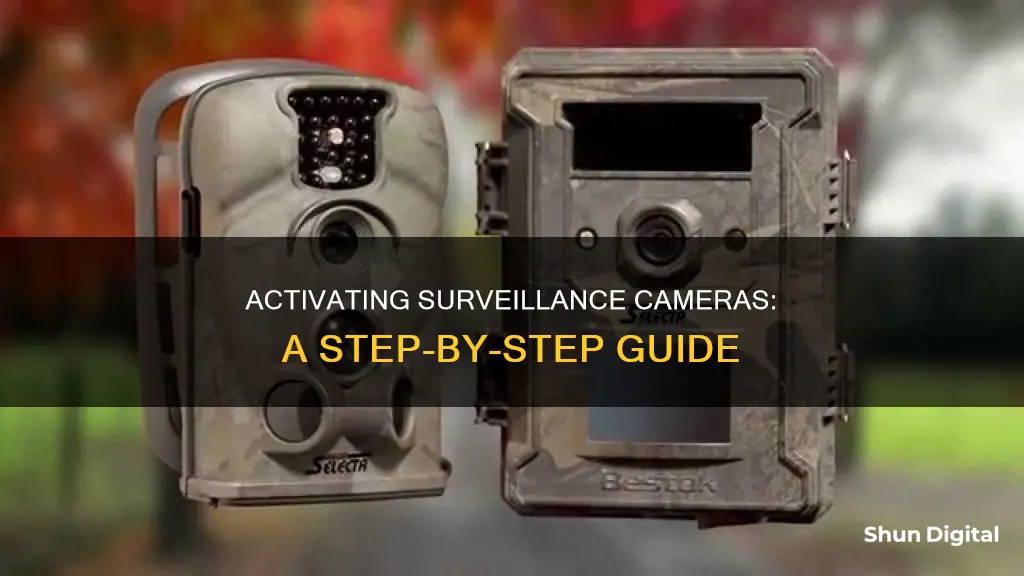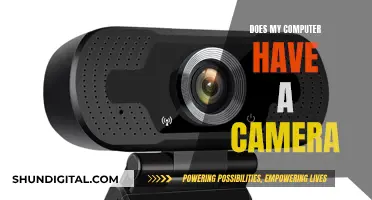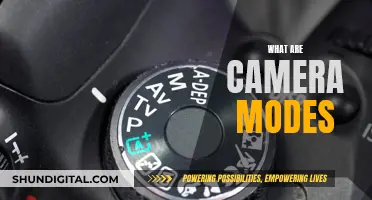
Surveillance cameras are essential for maintaining security and safety in various settings, including homes, offices, and public places. They serve multiple purposes, such as deterring criminal activities, monitoring employee performance, and providing valuable evidence in case of theft or other incidents. To activate a surveillance camera, it is necessary to ensure proper installation, a stable power source, and configuration tailored to specific requirements. This process may involve following instructions provided in manuals or online guides. Additionally, factors like lighting conditions and camera placement play a crucial role in optimising the effectiveness of surveillance cameras.
What You'll Learn

Proper installation and power source connection
Proper installation and connection to a power source are crucial steps in activating a surveillance camera. Here are some detailed instructions to ensure your cameras are set up correctly:
Planning the Installation:
First, determine the optimal locations for your cameras, considering factors such as height, shelter from weather, unobstructed views, and proximity to power sources. For wired cameras, plan the route for the security camera wires, especially if installing in multiple locations or across different floors.
Mounting the Cameras:
Use the provided mounting brackets and screws to secure the cameras to the desired spots. Drill holes and screw the cameras tightly into place, ensuring they are positioned correctly and angled to capture the desired field of view.
Connecting the Power:
The power source for your surveillance cameras will depend on the type of camera you have. Wired cameras, such as PoE (Power over Ethernet) cameras, require an Ethernet cable to transmit data and power the camera. Wireless cameras, on the other hand, may be battery-powered, solar-powered, or plugged into an electrical outlet.
For wired cameras:
- Connect the camera to a PoE switch or router using an Ethernet cable.
- Plug the PoE switch or router into a power source.
For wireless cameras with a power cable:
- Plug the camera into an electrical outlet. Ensure it is within a safe distance from the camera.
- Alternatively, connect the camera to a power adapter and plug it into a socket.
For wireless cameras with removable batteries:
Insert the batteries into the designated battery slot.
For solar-powered wireless cameras:
- Install a solar panel in a position that receives ample sunlight.
- Adjust the angle to optimise direct sunlight exposure.
- Connect the solar panel to the camera using a micro USB cable.
Finalising the Setup:
Once the cameras are mounted and powered, open the official app of the security camera brand and follow the in-app instructions to complete the initial setup. Check the camera views, ensure they are functioning correctly, and make any necessary adjustments.
Trail Camera Power: Battery Options for Stealth Cameras
You may want to see also

Camera type and location
When it comes to choosing the right surveillance camera for your needs, there are several options to consider in terms of camera type and location.
Firstly, it is important to assess the functionality you require from your camera. For example, do you need a camera that can capture footage overnight or in low-light conditions? This will help determine the type of camera that would be most suitable.
- Pan Tilt and Zoom (PTZ) CCTV: These cameras can move side to side, up and down, and zoom in and out. They are useful for larger sites or premises with potential blind spots.
- Infrared Night Vision Surveillance Cameras: These cameras are ideal for properties left unoccupied overnight as they can record high-quality footage in complete darkness using infrared LEDs.
- Day and Night CCTV Systems: These cameras can operate in any light condition, providing clear footage regardless of glare or shadows.
- Dome CCTV Camera Fixtures: Dome-shaped cameras are commonly used in public transport as they can be rotated 360 degrees and are difficult to tamper with due to their high fixing location.
- Bullet CCTV Installations: Bullet cameras are the most conventional type of CCTV and are often used outdoors. They are resistant to dirt, water, and dust and can capture footage over long distances.
- C-Mount Surveillance Cameras: Similar to bullet cameras, C-Mount cameras have detachable lenses and are commonly used in the construction industry and for monitoring roads and access points.
In terms of location, you should consider key entrances and exits, access points, the size and layout of the site, power accessibility, and potential security threats.
For indoor cameras, it is recommended to place them on the ground level of your home, avoiding private areas such as bathrooms and bedrooms. Cover any easily accessible areas, such as front hallways, and central rooms like living rooms.
For outdoor cameras, consider placing them on all ground-floor entrances, taking into account the camera's range and any potential blind spots. Ensure that outdoor cameras are weather-resistant and can withstand varying temperatures and weather conditions.
Additionally, video doorbells or doorbell cameras can be useful for monitoring your front door. These cameras may include a chime or replace your existing doorbell setup, allowing you to see and speak to guests remotely through a mobile application or smart home device.
By carefully selecting the type and location of your surveillance cameras, you can ensure that you have optimal coverage and security for your premises.
Understanding Camera Raw: Processed or Not?
You may want to see also

Security and privacy
Surveillance cameras are an increasingly common feature of modern life, with many people and businesses choosing to install them to enhance security and safety. However, it is important to carefully consider the security and privacy implications of activating and using surveillance cameras.
Legal Requirements and Privacy Rights
Surveillance cameras are subject to various legal requirements that can vary depending on location and purpose. In most jurisdictions, it is necessary to inform people that they are being monitored and to respect their privacy rights. For example, in the US, citizens are guaranteed a "reasonable expectation of privacy" in private places such as bathrooms, meaning that recording in these areas is prohibited. Some states have stricter security camera laws than federal regulations, so it is important to check local laws before installing cameras.
Consent and Notification
In addition to legal requirements, obtaining consent and providing notification are important considerations. While the specific laws around consent can vary, it is generally illegal to record audio without the consent of at least one party. In some states, the consent of all parties is required for audio recording. While posting signs notifying people of video surveillance may not be legally required, it can help avoid potential consent issues and future legal headaches.
Data Security
Surveillance cameras can be powerful tools for monitoring and security, but they also collect sensitive data. As such, it is important to ensure that cameras are properly secured to prevent hacking. This includes measures such as password protection and keeping firmware up to date. Additionally, the data collected by surveillance cameras should be protected and shared only when necessary.
Ethical Considerations
Beyond legal and technical considerations, it is important to think about the ethical implications of surveillance cameras. While cameras can enhance security, they can also invade privacy and create a sense of unease for those being monitored. Striking a balance between security and privacy is crucial, and this may involve measures such as ensuring cameras are only placed in appropriate, well-considered locations.
In conclusion, while surveillance cameras can provide important security benefits, it is essential to carefully consider the security and privacy implications for all stakeholders. This includes complying with legal requirements, respecting privacy rights, securing data, and considering the potential ethical impact on individuals and communities.
Mastin Labs and Adobe Camera Raw: A Perfect Match?
You may want to see also

Lighting and camera positioning
The effectiveness of a surveillance system is largely dependent on two factors: lighting and camera placement. Proper lighting and camera positioning can help improve image clarity and reduce the risk of glare or reflections that may obscure the image.
Lighting
When setting up a surveillance system, it is important to consider the lighting conditions as they can greatly impact the quality of the footage captured. Here are some lighting factors to consider:
- Low Light Conditions: In low light conditions, it is recommended to use cameras with low-light capabilities or add additional lighting to the area to improve image clarity.
- Backlighting and Glare: Adjust the camera angle or add a backlight to the subject to avoid halo effects caused by light sources positioned behind them.
- Night Vision and Infrared (IR) Lighting: IR lighting is often used to enhance visibility in dark environments. However, too much IR lighting can lead to overexposed or washed-out images.
- Artificial Lighting: Use lighting fixtures that are compliant with industry standards and avoid creating hot spots or shadows in the footage.
- Natural Lighting: Consider the movement of the sun, seasonal changes, environmental elements, and obstructions when positioning cameras and lighting fixtures.
Camera Positioning
Strategic camera placement is crucial for optimal video surveillance. Here are some factors to consider when positioning cameras:
- Area to be Monitored: Identify specific areas that require surveillance, such as entry/exit points, high-risk areas, parking lots, or outdoor spaces.
- Camera Angle and View: Determine the optimal camera angle and view based on the area being monitored. Choose between a wide-angle or narrow, focused view accordingly.
- Camera Height and Distance: Ensure the camera is positioned at an appropriate height and distance to effectively monitor the area while also being out of reach of potential vandals.
- Obstructions: Identify any potential obstructions, such as trees or pillars, that could block the camera's view and adjust its position accordingly.
- Accessibility and Security: Place the camera in a location that is easily accessible for maintenance while also taking security precautions to prevent tampering.
By considering these lighting and camera positioning factors, you can improve the effectiveness of your surveillance system, enhance image clarity, and reduce blind spots.
Understanding Camera Raw Cache in Adobe Software
You may want to see also

Maintenance and cleaning
Digital Maintenance
Digital maintenance is necessary for sustaining and monitoring performance and for effective cybersecurity. This involves the timely application of firmware and software upgrades.
Physical Maintenance
Physical maintenance of surveillance cameras is equally important but often overlooked. It is essential to keep the camera lens and night vision system free from water spots, dust, and grime. These spots can cause the video to appear cloudy at night and out of focus during the day. By simply cleaning the camera, you can increase video clarity by 40% or more. Therefore, it is recommended to clean the camera bi-annually and protect the lens with a long-lasting hard water and grime repellent.
Additionally, the camera's infrared night vision system can attract moths and bugs, which then attract spiders. The spiderwebs can cross into the camera's field of view, causing fuzzy night vision images and reduced night vision distance. To prevent this, spray the camera with a long-lasting bug and spider repellent bi-annually.
It is also important to check the connections and cables of your surveillance camera regularly. Over time, these can erode or loosen, leading to potential blackouts. Check cables and harnesses for wear and fray, ensure proper dressing, and reconnect any loose cables or wires.
Finally, clean your NVR/DVR hardware with a dry microfiber cloth to prevent dust buildup and overheating.
By following these maintenance and cleaning tips, you can ensure your surveillance cameras remain in optimal condition and provide clear and reliable footage.
Are Batteries Included? Camera Shopping Basics
You may want to see also
Frequently asked questions
To activate a surveillance camera, you need to ensure it is properly installed, connected to a power source, and configured according to your needs. Most cameras will come with a manual or online guide with instructions on how to activate them.
There are several types of surveillance cameras, including dome cameras, bullet cameras, PTZ cameras, and thermal cameras. Each type has unique features and benefits, making them suitable for different applications.
When choosing a surveillance camera, consider factors such as location, lighting conditions, and the level of security required. Also, consider the camera's features, such as resolution, night vision, and motion detection.







